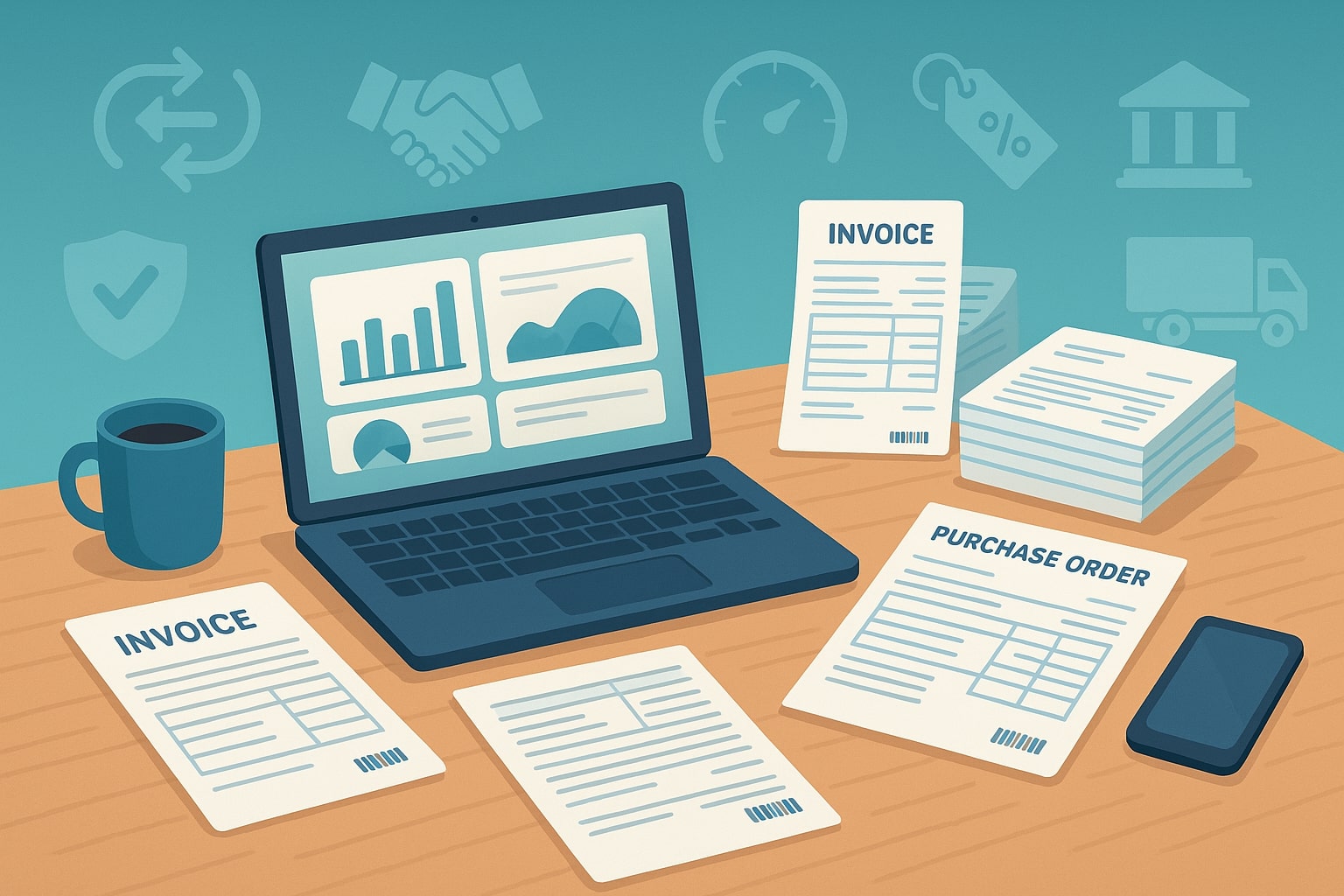
Invoice Factoring Companies: What to Look For
Invoice factoring (or accounts receivable financing) allows U.S. businesses to convert outstanding customer invoices into immediate cash. In this arrangement, a factoring company purchases your unpaid invoices at a discount, advancing most of the invoice amount upfront and handling collections in return for a fee.
This can be a lifeline for businesses – from small manufacturers and staffing agencies to trucking firms and even independent consultants – that need to bridge cash-flow gaps without taking on new debt.
Because factors purchase your receivables outright, the cash you receive is not a loan at all, but payment for work already done. However, invoice factoring firms differ in terms, fees, and industry focus.
Choosing the right factoring partner requires careful comparison of each company’s expertise, pricing structure, contract requirements and level of service. This guide explains how invoice factoring works, its pros and cons, and the key factors to consider when evaluating U.S.-based invoice factoring companies.
Understanding Invoice Factoring
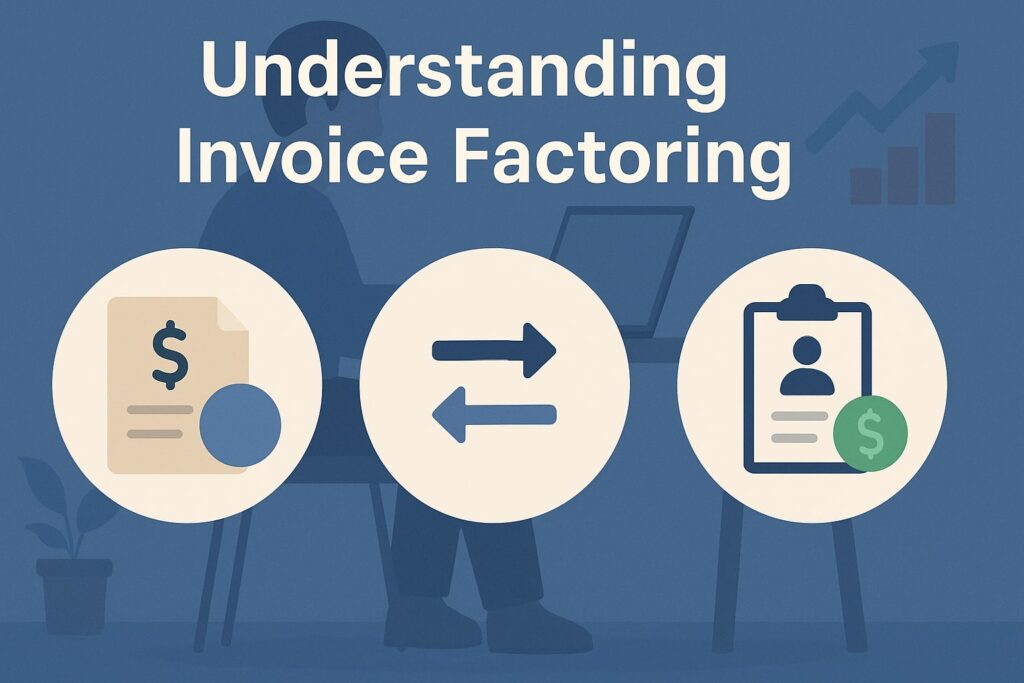
Invoice factoring defined. Invoice factoring is when you sell your unpaid B2B invoices to a factoring company at a discount, in exchange for cash up front. In effect, you receive an advance on your invoices (often 70–95% of the invoice value immediately) and the factor collects payment from your customer.
Once your customer pays, the factor remits the remaining balance to you, minus a factoring fee. For example, selling a $10,000 invoice with an 85% advance rate would yield $8,500 up front. If the factoring fee is 3% for a 30-day collection period, the factor charges $300.
After the customer pays, the factor would send you the remaining 15% ($1,500) minus the $300 fee – a total of $9,700 in this example. This mechanism provides fast access to cash (often within 24–48 hours) without increasing your debt load.
How it works (simplified steps)
- Issue invoice: Your business delivers goods or services to a B2B customer and sends them an invoice (often with 30–90 day terms).
- Sell to factor: You assign that invoice to a factoring company under contract.
- Advance payment: The factor advances you a large percentage (typically 70–95%) of the invoice amount right away.
- Customer payment: The factor takes over collection and your customer pays the invoice directly to the factor.
- Settle balance: After payment, the factor pays you the remaining balance of the invoice, minus the agreed factoring fee.
This process is not a loan or line of credit. You are not borrowing money and making interest payments – you are effectively selling your account receivable.
Since it’s a sale of an asset, you don’t incur new debt or loan obligations. The only cost is the factoring fee (usually expressed as a percentage of the invoice per 30 days), which replaces any interest you would pay on a loan.
Invoice factoring goes by several names: accounts receivable factoring, invoice financing or invoice discounting. In all cases, the core idea is the same – turning invoices into immediate working capital.
For instance, a modern factoring platform might deposit the full value of an invoice into your bank account quickly (sometimes next business day), even though they technically advance you a percentage and remit the remainder later.
How Invoice Factoring Differs from Other Financing
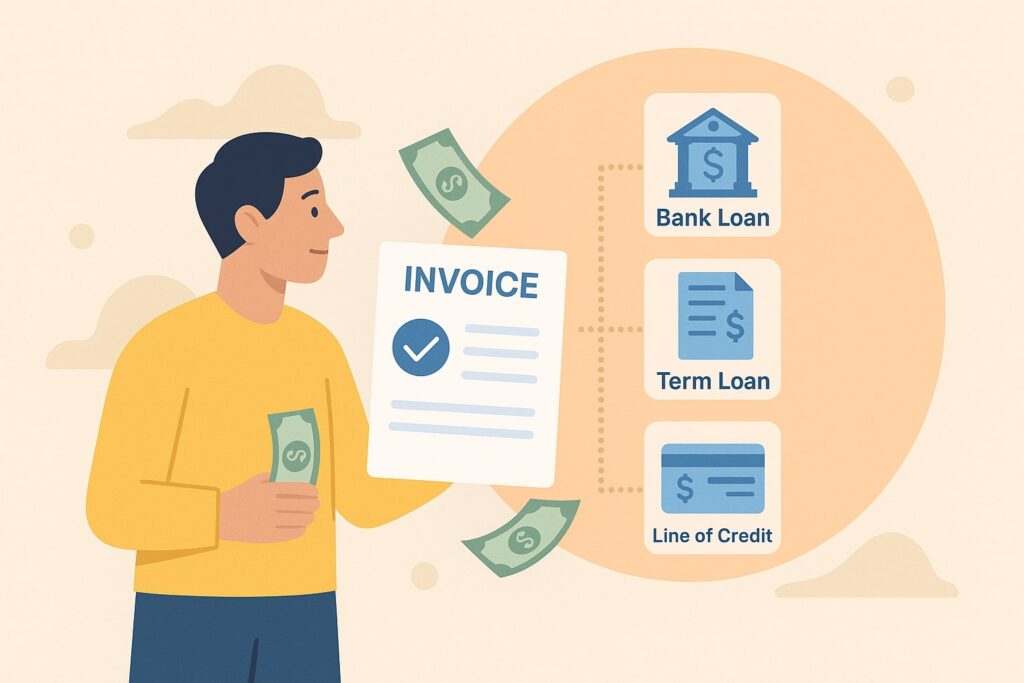
Invoice factoring has unique features that distinguish it from lines of credit and traditional loans:
- Not a loan: You sell your invoices rather than borrowing against them. There is no principal balance to repay, and no interest charges – only factoring fees.
Because it’s not a debt obligation, factors may approve businesses with little credit history, as approval depends mainly on the creditworthiness of your invoiced customers. - Quick funding: Unlike a bank loan or line of credit (which can take weeks to approve), factoring can provide cash in as little as 24–48 hours after invoice assignment. This is ideal for tight cash needs.
- Flexible, as-needed basis: Factoring is generally non-recurring – you factor only the invoices you choose. This can be more flexible than a loan that comes with fixed payments.
- Customer involvement: Because the factor collects from your customers, they will be notified that payments should go to the factor. This can affect customer relations, so transparent communication is important.
(Many businesses weigh the cash benefit against any possible discomfort their customers might feel about dealing with a third party.) - Advance rate vs borrowed amount: In a loan or credit line, you receive a lump sum or draw funds up to a credit limit. With factoring, the amount you get is directly tied to your invoice amounts – you can usually factor 70–95% of each invoice.
In summary, invoice factoring is essentially a sale of future cash (your receivables), not the creation of new debt. It’s often easier to qualify for than a loan, because the factor’s risk is tied to your customers’ ability to pay.
On the other hand, factoring fees (commonly 1–5% of invoice value per 30 days) can be higher than typical interest rates, making it more expensive per dollar borrowed.
Benefits of Invoice Factoring
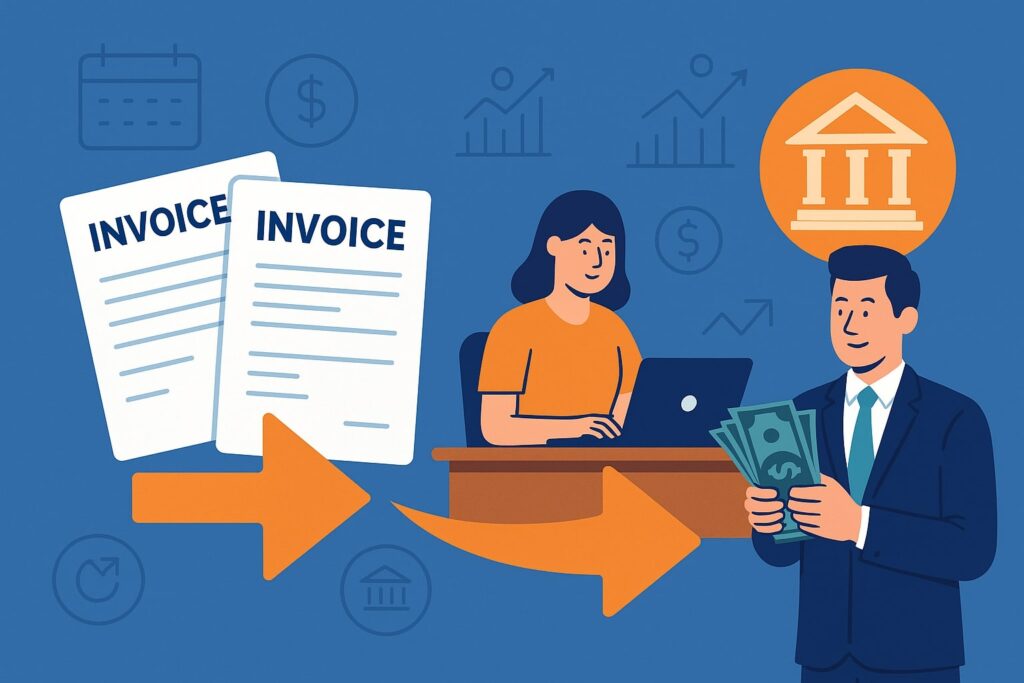
Invoice factoring offers several advantages for businesses that invoice other businesses:
- Immediate cash flow: By accelerating payments on outstanding invoices, factoring unlocks working capital that would otherwise be tied up. This can be used for payroll, inventory, expansion or unexpected expenses.
As one industry source notes, “invoice factoring is a financial tool that helps businesses get paid faster for work they have already delivered”. This means you no longer have to wait 30–90 days for customer payments. - No debt or collateral: Since factoring is not a loan, it doesn’t create a repayment obligation on your balance sheet. You don’t incur interest or a loan lien on assets. In fact, factors often do not require personal guarantees; their main collateral is your invoice.
This preserves your borrowing capacity with banks. A Rivieria Finance whitepaper explains that factoring “gives businesses the power to ensure growth without diluting equity or incurring debt”. - Easier qualification: Traditional loans often require years in business, high credit scores, and personal guarantees. In contrast, invoice factoring approval rests heavily on your customers’ creditworthiness, not yours.
Thus, even startups or firms with limited credit history may qualify if they have invoiced reputable companies. According to OnDeck, qualifying for factoring is often easier than a bank loan because “it’s not a form of borrowing… you may get approved even with little to no credit history”. - Outsourced collections: Many factoring companies provide credit checks on your customers and handle the collections process. This can relieve your staff from chasing payments and let you focus on running the business.
Some factors even monitor client credit to protect you from bad customers. High-quality factors will do thorough debtor credit analysis to minimize risk. - Flexible application: Factoring is on-demand: you choose which invoices to factor and when. This means you only pay fees on the invoices you need funding for, unlike a fixed-payment loan.
There is usually no long-term commitment – many factors allow month-to-month or per-invoice arrangements. - Scalable financing: As your sales grow (and you issue more invoices), you can factor more and access larger cash advances.
Some top factors offer very large funding limits (into the tens of millions) for growing companies. This scalability supports expanding operations or big seasonal orders.
In a tightening credit environment, factoring can be a strategic tool. A market report notes that many fintech lenders and even large banks (e.g. PayPal, JPMorgan) are offering factoring to small businesses and freelancers facing delayed payments.
The U.S. factoring market itself was valued at $172 billion in 2024 and is projected to grow at about 9.4% annually through 2030. This growth underscores how factoring is gaining popularity as an alternative funding solution for the U.S. SMEs.
Drawbacks and Considerations
While invoice factoring can boost cash flow, it also has downsides that businesses should weigh:
- Cost: The primary disadvantage is cost. Factoring fees (discount rates) typically run from about 1% to 5% of the invoice value per 30 days. If a customer takes longer to pay, fees accumulate.
As OnDeck’s guide notes, “factoring fees can be expensive, making invoice factoring a more costly type of business financing than some traditional methods”.
In our $10,000 invoice example, a 3% fee equated to an effective APR of ~42% for a 30-day period. Businesses must compare this cost against the benefit of accessing cash now. - Reduced invoice proceeds: Because the factor deducts its fee, you will never receive 100% of an invoice’s face value. This “cost of capital” must be factored into pricing and margins. Over many invoices, high fees can materially reduce profits if not managed.
- Potential contract terms: Some factoring agreements have minimum monthly volume requirements, long-term contracts, or upfront set-up fees.
You should be careful of clauses requiring you to pledge all your eligible invoices or to re-purchase uncollectible invoices (in recourse agreements). Be aware of any long-term lock-in or early termination fees. - Customer perception: Factoring notifies your customers that a third party is handling collections. While most B2B clients are accustomed to this, some businesses worry it could signal cash problems or sour relationships.
It’s important to choose a factor that treats your customers professionally and aligns with your brand. - Limited eligible invoices: Only invoices due from creditworthy businesses can be factored. If your clients are small or slow to pay, you may not qualify to factor those invoices. Some factors also impose minimum invoice sizes (often $500–$1,000) or minimum monthly volumes.
- Risk of recourse liability: If you enter a recourse factoring agreement, you remain ultimately responsible for any invoice that goes unpaid.
In that case, you might have to buy back or reimburse the factor for delinquent accounts. This risk is essentially like having the debt return to you. We discuss recourse vs. non-recourse next.
Recourse vs. Non-Recourse Factoring
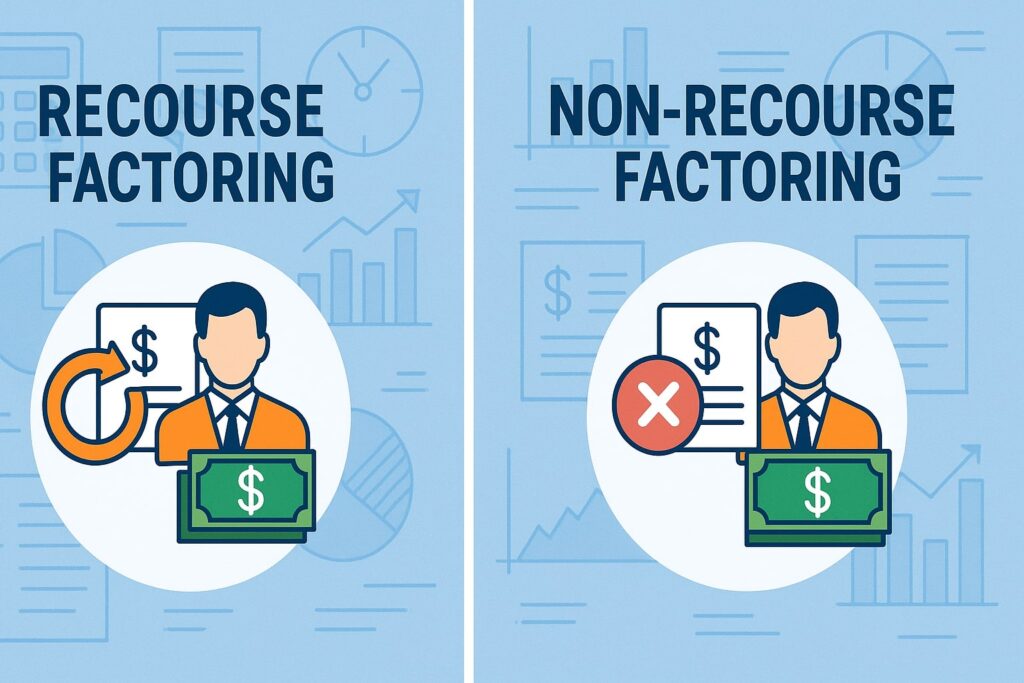
Types of agreements: The two primary forms of factoring are recourse and non-recourse. In resource factoring, your business is “on the hook” if a customer fails to pay; the factor can legally require you to refund the advance or replace the invoice with another.
In non-recourse factoring, the factor assumes the credit risk: if your customer defaults, the factor takes the loss.
- Recourse factoring: This is more common and typically has lower fees. Because you bear the ultimate risk, factors charge less for each transaction. Your credit and liquidity may also face strain if you have to make up unpaid invoices.
However, many recourse factors mitigate this risk by performing strict credit checks on your customers. Some factors that only offer recourse will still do free credit analysis to protect you from risky clients. - Non-recourse factoring: With non-recourse, the factor guarantees payment on the invoice, insulating you from customer default (except in rare cases of fraud or dispute).
This peace of mind comes at a premium: non-recourse agreements usually carry significantly higher fees to cover the factor’s risk. Not all invoices qualify for non-recourse; factors often restrict it to invoices of customers with excellent credit in stable industries.
What to choose
Non-recourse can be valuable if you fear taking on bad debt, especially in industries with credit volatility. But for most small businesses, recourse factoring is adequate when paired with due diligence.
The altLINE guide suggests that even factors which require recourse (like altLINE itself) provide protections via credit vetting to minimize your exposure. Always clarify which model a factoring company uses and understand the implications for your business.
Industries and Businesses That Use Factoring
Common sectors: Invoice factoring is popular in industries where businesses routinely extend credit to corporate clients or have large invoice volumes. These include:
- Freight and trucking: This is one of the largest factoring markets in the U.S. Trucking companies often use freight factoring because carriers typically wait 30–90 days for payment after delivering goods.
Specialized trucking factors (e.g. RTS Financial, TCI Business Capital) routinely advances 90+% of invoice value. - Staffing and payroll: Temp agencies and staffing firms invoice clients after workers are placed, often with delayed payment terms. Factoring helps them meet payroll and cover staff costs in the interim. Many factors explicitly target staffing firms.
- Distribution and manufacturing: Companies selling goods to other businesses (distributors, manufacturers) frequently have unpaid accounts receivable. Factoring helps these B2B firms maintain inventory and growth without borrowing.
- Service industries (IT, staffing, telecom, oil & gas, etc.): Any service provider issuing invoices can factor them. For example, oil field service companies, software consultants, and telecom contractors use factoring to smooth cash flow.
- Small businesses and startups: A variety of small U.S. companies – from marketing agencies to construction contractors – leverage factoring if they have steady B2B clients. It can be especially useful for younger firms that cannot qualify for bank loans but have sizable receivables.
In fact, recent market reports note that many fintech and traditional financial firms now offer factoring to not only SMEs but even freelancers, to alleviate delays in payments.
Freelancers and Sole Proprietors
While invoice factoring is most common for businesses, some self-employed professionals (e.g. independent consultants or contractors) with substantial corporate clients may use factoring-like services (often called invoicing financing).
For instance, factors like FundThrough or Bluevine cater to smaller invoice amounts and integrate with accounting software. However, not all factors work with sole proprietors—requirements vary.
If you are a freelancer, look for factors that explicitly support independent contractors and offer small-ticket financing.
Overall, if your business invoices other companies and faces slow-paying clients, invoice factoring can be a practical tool. It bridges the cash gap between completing work and getting paid, often without the stringent requirements of bank credit.
As Fundbox notes, factoring is “specifically designed for businesses that issue invoices with net terms… to get access to extra funding quickly”.
Key Factors When Choosing a Factoring Company
Not all factoring companies are alike. Here are the most important criteria to evaluate when selecting a U.S. invoice factoring partner:
- Industry expertise: Choose a factor experienced in your business sector. Factors who specialize in trucking, staffing, or your industry will understand your cash-flow cycles and can vet customers more effectively.
For example, some factors specifically advertise support for trucking fleets or staffing agencies. An industry-savvy factor can also tell you which types of customers they are likely to accept. - Transparency of fees: Insist on clear, upfront disclosure of all fees and rates. Understand the discount rate (the factoring fee), any setup/origination fees, due diligence fees, monthly minimums, and any contingency fees for non-payment.
Beware of hidden costs. The best providers clearly explain their fee structure and do not bury clauses in the contract. - Advance rate and funding speed: Compare how much of each invoice the company will advance (often up to 80–97% of face value) and how quickly you receive funds. Many top factors are found within 24–48 hours of invoice submission.
If you need immediate liquidity, find a factor that guarantees rapid turnaround. Check also for maximum funding limits; some factors will only finance invoices up to a certain size or only finance your largest invoices. - Recourse vs non-recourse options: Decide whether you need non-recourse protection and confirm if the factor offers it. Remember, non-recourse reduces your risk but costs more.
Ensure you understand the recourse obligations in your contract. Some factors (like Riviera Finance) advertise non-recourse factoring, while others (like altLINE) typically use recourse but help mitigate risk via credit analysis. - Contract terms and flexibility: Check contract length (month-to-month vs one-year agreement) and any volume requirements. Factors like Scale Funding specialize in month-to-month contracts, which can be ideal for seasonal businesses or those cautious about long commitments.
Others may require a longer commitment for lower rates. Understand any termination fees or mandatory invoice volume minimums. - Customer service and reputation: Look for factors with strong customer reviews and responsive service. Good factors act as partners and provide personal support.
For example, altLINE (SOFI Bank’s factoring arm) is noted for “exceptional customer service” and bank affiliation. Check ratings on review sites (Trustpilot, BBB) and ask for references. A company backed by a bank or with an established track record often offers additional stability. - Technology and convenience: Modern factors offer online portals and integrations (with QuickBooks or other accounting software) to submit invoices and view account status.
If you want real-time access and easy uploads, choose a factor with a good tech platform. For example, FundThrough is known for software integration and API-driven submissions. Ease of use can significantly reduce administrative headaches. - Funding capacity: Ensure the factor has sufficient financial capacity for your needs. Some factors cap total exposure per client or per invoice.
If you plan rapid growth or have very large invoices, pick a factor that advertises high funding limits (e.g. up to $30 million). A well-capitalized firm (often a bank-backed factor) can scale with you. - Additional services: Some factoring companies offer value-adds like credit checks, collections support, or supply-chain financing. For instance, many factors will perform credit analysis on your customers at no extra cost, helping protect your business.
Others might provide early-pay programs, fuel card integration (for truckers), or accounts receivable management tools. Decide which extra services would benefit you.
Each of these factors can be bullet-pointed or compared. Below is a summary list of key criteria:
- Experience in your industry (handles your type of clients)
- Clear, upfront fee and rate disclosure
- High advance rates and speedy funding turnaround
- Recourse terms (are you on the hook for bad debt?)
- Flexible contract terms and no hidden clauses
- Strong customer support and reputation (reviews, bank backing)
- Easy-to-use technology (online portal, integrations)
- Adequate funding limits for your invoice sizes
- Helpful ancillary services (credit vetting, data reporting)
By prioritizing these factors, you can narrow your search to providers that fit your business needs. For example, if you value face-to-face relationships and non-recourse options, a company like Riviera Finance (with 25+ offices and non-recourse offerings) might appeal.
If you want banking-level security and low rates, a bank-owned factor like altLINE could be ideal. Always meet with or call potential factors with a list of questions to ensure transparency and a good fit.
Top U.S. Invoice Factoring Companies
Several invoice factoring companies stand out in the U.S. market for their specialties, size, or customer service. Below is a sampling of notable providers and their key features (figures are approximate and subject to change):
| Factoring Company | Best For (Specialty) | Advance Rate | Factor Fee (Monthly Discount Rate) | Funding Time | Notes/Source |
|---|---|---|---|---|---|
| altLINE Financial (SoFi) | Small businesses, startups, diverse industries | Up to 90% | ~0.75%–3.5% per invoice | Within 24 hrs | Bank-affiliated (Southern Bank), trusted service |
| FundThrough | Accounting software integration | 100% (max) | ~2.2%–8.25% per invoice | Next business day | Integrates with QuickBooks, AI-driven |
| Riviera Finance | In-person factoring, non-recourse | Up to 95% | ~2.0%–5.0% per invoice | ~24 hours | 25+ offices in U.S./Canada; non-recourse options |
| RTS Financial | Trucking/freight factoring | Up to 97% | Not publicly disclosed | Within 24 hrs | Specializes in transportation sector |
| eCapital Merchant Capital | Large invoices, fast funding | Up to 90% | ~1.0%–5.0% per invoice | Same day (often) | Up to $30M funding; offers non-recourse |
| Universal Funding Corp. | Large freight invoices | Up to 95% | ~0.55%–2.00% per invoice | ~24 hours | Capable of financing large loads |
| Scale Funding (TCI Biz Cap) | Flexible, month-to-month contracts | Up to 90% | Not disclosed | 24 hours | Good for seasonal businesses |
(Sources: LendingTree, altLINE blog and company sites)
Each of these companies has a different niche and pricing model. For example, altLINE (part of a bank) is noted for low rates and wide industry acceptance, while Riviera Finance emphasizes its long history (since 1969) and personalized in-person service.
FundThrough stands out for allowing 100% invoice advances (though at higher fees) and tight integration with accounting software. RTS Financial and Universal Funding are leaders in freight/trucking factoring.
Before choosing, compare multiple quotes – rates and terms can vary widely. Factoring brokers or marketplaces (such as FactorFinders) can help match you with options.
Costs and Fees of Factoring
Understanding pricing is crucial. Factors charge a “discount rate” (factoring fee) on each invoice, typically expressed as a percentage per 30-day period. According to industry averages, you can expect 1% to 5% per month of invoice value. Several variables influence the rate:
- Invoice volume and size: Larger invoices and higher monthly volume usually garner lower percentage rates.
- Customer credit quality: If your customers are rock-solid (e.g. large corporations), the factor’s risk is lower, so you may pay a smaller fee. Riskier debtors mean higher fees.
- Recourse vs non-recourse: Non-recourse agreements typically have higher fees, reflecting the factor’s additional risk.
- Contract terms: Longer commitment contracts might have lower rates; ad-hoc or short-term deals may cost more.
- Speed and advance percentage: Factors charging very fast funding and high advance rates sometimes charge higher fees overall.
In practice, factors often give a rate “range” and then quote a specific rate after reviewing your business. For example, altLINE advertises factor rates “as low as 0.80%” for some industries, whereas a trucking specialty factor might charge 3% or more.
A useful example: if the factor’s fee is 3% per 30 days, then on a $10,000 invoice your fee for 30 days is $300. If payment takes 60 days, you might pay 6% (i.e. $600) total.
Additional charges: Beyond the basic factor rate, watch for extra fees. These could include:
- One-time setup or origination fees (often a few hundred dollars).
- Monthly minimum or maintenance fees (some factors require you to pay a base fee if your submitted invoices fall below a threshold).
- “Processing” or “administration” fees.
- Wire transfer or collection fees (especially for non-domestic or ACH transfers).
- Early termination fees (if you cancel a contract prematurely).
Always request a sample contract and a full fee schedule. A reputable factor will clearly list and explain any fees. The sum of fees can be compared to the amount you get upfront: in effect, the effective interest rate on factoring can be high (NerdWallet’s example reached ~42% APR). Therefore, treat factoring fees as a cost of doing business and plan margins accordingly.
Frequently Asked Questions (FAQs)
Q: Isn’t factoring just like a loan or line of credit?
A: No. Unlike a loan or credit line, factoring is not debt. It’s the sale of an asset (your invoice). You aren’t taking on a repayment obligation. Instead of borrowing funds, you receive an advance on money that’s already owed to you. Because of this, factors often have more relaxed qualifications than banks, as discussed above.
Q: What is the difference between recourse and non-recourse factoring?
A: In recourse factoring, you must eventually cover any invoices that go unpaid. The factor can demand repayment of advances for bad debts. In non-recourse factoring, the factor agrees to absorb the loss if a customer fails to pay (except in cases of fraud).
Non-recourse is safer for you but costs more. Factors often disclose which type they offer. For instance, Rivera Finance offers non-recourse options, while others primarily do recourse but protect you via credit checks.
Q: Will my customers know I’m using a factoring company?
A: Yes. When you factor an invoice, your customer is notified (either by your own communications or by the factor) to pay the factor. Essentially, payments are directed to the factoring company, not to you.
Most customers expect this in industries where factoring is common, but it’s best to inform them ahead of time. Reputable factors handle collections professionally to maintain good relations.
Q: How long does approval and funding take?
A: It varies by company, but many U.S. factors can approve and fund invoices within 24–48 hours of application and invoice submission. Getting approved (signing a contract) might take a few days as the factor evaluates your invoices and client credit.
Some fintech factors may offer streamlined online applications with instant quotes, while more traditional factors may require paperwork but still fund quickly once approved.
Q: What do factoring companies look at for approval?
A: They primarily underwrite your debtors, not your business. They will require a list of your customers and review creditworthiness or payment history of those customers.
Your business usually needs to be stable enough to have consistent invoicing (often 6–12 months in operation and a minimum monthly revenue, sometimes around $10K+) but little personal credit is needed.
They will also ask for copies of existing invoices you wish to factor, to ensure the transactions are legitimate.
Q: Can freelancers or consultants use invoice factoring?
A: Some can, especially if they invoice other businesses. Several fintech factoring companies (like FundThrough or Bluevine) market to small firms and independent contractors.
The key is having invoices owed by other companies, not individuals. Always check eligibility requirements: some factors need a formal business entity or a minimum invoice volume.
Q: How do I get started with invoice factoring?
A: First, gather financial documents: your account receivables aging, customer list, proof of delivery, etc. Then shop around: get quotes from a few factors to compare rates and terms. Factor brokers or marketplaces can simplify this.
When you find a potential factor, you’ll sign a factoring contract. After that, you submit (assign) invoices through the factor’s portal or process, and receive the advance. Most factors have a straightforward onboarding process.
Conclusion
Invoice factoring companies play a vital role in U.S. small-business financing by turning receivables into cash quickly. This can sustain growth, cover payroll, or fund new opportunities without traditional bank loans. However, not all factoring providers are equal.
When evaluating firms, focus on what to look for: transparent pricing, industry expertise, speed, and service. Assess whether you need non-recourse protection, ensure the contract is clear, and confirm the advance rates match your cash needs.
Comparing several factors – from bank-backed players like altLINE to specialized firms like RTS or Riviera – will help you find the best fit.
Ultimately, the right factoring company is one that aligns with your industry, offers fair terms, and supports your cash flow goals.
With careful selection and management of costs, factoring can be a powerful tool to convert invoices into immediate working capital and help your business thrive.